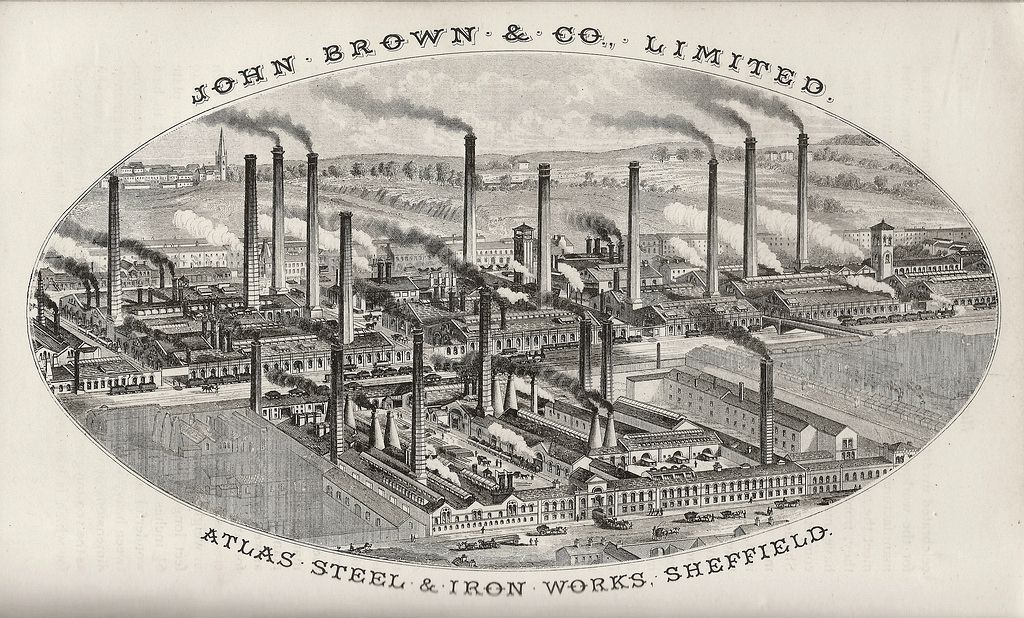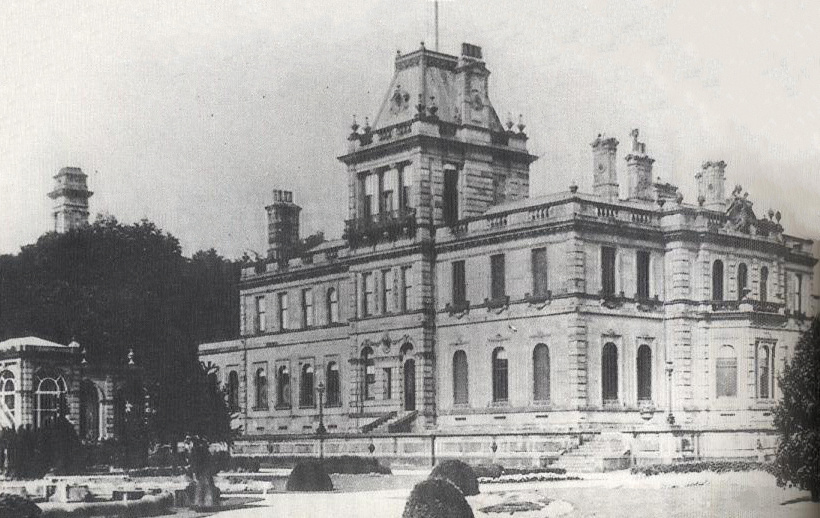John Brown (industrialist) on:
[Wikipedia]
[Google]
[Amazon]
Sir John Brown (6 December 1816 – 27 December 1896), British industrialist, was born in
File:Evolutfeder.png, Conical, or
Gives biographical details. Brown's great achievement was the development of
Brown's great achievement was the development of

 In 1864, his business was converted into a limited liability company, and he retired to Endfield Hall, Ranmoor, near Sheffield.
He was Mayor of Sheffield in 1862 and 1863, and
In 1864, his business was converted into a limited liability company, and he retired to Endfield Hall, Ranmoor, near Sheffield.
He was Mayor of Sheffield in 1862 and 1863, and
Sheffield
Sheffield is a city status in the United Kingdom, city in South Yorkshire, England, whose name derives from the River Sheaf which runs through it. The city serves as the administrative centre of the City of Sheffield. It is Historic counties o ...
. He was known as the Father of the South Yorkshire Iron Trade.
Background
He was born atSheffield
Sheffield is a city status in the United Kingdom, city in South Yorkshire, England, whose name derives from the River Sheaf which runs through it. The city serves as the administrative centre of the City of Sheffield. It is Historic counties o ...
in Flavell's Yard, Fargate
Fargate is a pedestrian precinct and shopping area in Sheffield, England. It runs between Barker's Pool and High Street opposite the cathedral. It was pedestrianised in 1973.
Fargate also holds a Continental Market approximately 4 times a year, ...
, on 6 December 1816.
He was the second son of Samuel Brown, a slater
A slater, or slate mason, is a tradesman, tradesperson who covers buildings with slate.
Tools of the trade
The various hand tool, tools of the slater's trade are all drop-forged.
The slater's hammer is forged in one single piece, from crucib ...
of that town.
He was educated at a local school held in a garret, and was apprenticed at the age of fourteen to Earl, Horton, & Co., factors, of Orchard Place,
In 1831, his employers engaged in the manufacture of files and table cutlery, taking an establishment in Rockingham Street, which they styled the Hallamshire Works.
Nonetheless he did take over the company's factoring business with the help of a loan for £500 thanks to the backing of his father and uncle and for several years travelled the country selling goods.''"Aspects of Sheffield 1"'', Melvyn Jones (Editor), , Chapter "Endcliffe Hall: A Gentleman Industrialist Residence” by Julie Goddard Gives biography of Brown. In 1839, he married Mary (b. 1813 – died 28 November 1881), eldest daughter of Benjamin Scholefield of Sheffield. Brown lived with his wife throughout much of his working career at Shirle Hill in Sheffield. He died without issue at Shortlands
Shortlands is a suburb of South East London, England, within the London Borough of Bromley. It has been part of Greater London since 1965, and was previously part of the historic county of Kent. It is located between Beckenham and Bromley, to t ...
, the house of Mr. Barron, Bromley in Kent, on 27 December 1896, and was buried at Ecclesall on 31 December.
Career
He started his own company John Brown & Company in 1844 manufacturing steel at a small foundry on a site at what is the nowOrchard Square
Orchard Square is a small open-air court shopping centre located in Sheffield, England. It opened in 1987 and contains several stores, notably Schuh, Clarks, Waterstone's (with its own instore coffee house), Subway, The Body Shop and TK Maxx ( ...
Shopping centre. The business prospered so well that he sold his factoring firm and moved to larger premises on Furnival Street.
Invention of volute spring buffer
In 1848 Brown invented the conical steel spring buffer for railway carriages which he sold to theLondon and North Western Railway
The London and North Western Railway (LNWR, L&NWR) was a British railway company between 1846 and 1922. In the late 19th century, the L&NWR was the largest joint stock company in the United Kingdom.
In 1923, it became a constituent of the Lo ...
as well as other railways throughout the UK.
volute spring
A volute spring, also known as a conical spring, is a compression spring in the form of a cone (somewhat like the classical volute decorative architectural ornament). Under compression, the coils slide past each other, thus enabling the spring to ...
File:Buffer 1 (Otto's Encyclopedia).jpg, Diagram showing volute spring within buffer assembly
File:Puffer alt.jpg, Volute spring within buffer assembly on coach
File:Stangenpuffer2-Essen Zollverein-080604-cl.jpg, Volute spring within buffer assembly on coach
File:Buffer 2 (Otto's Encyclopedia).jpg, Diagram showing volute spring within buffer assembly on coach chassis
File:2007 0606 125GOT SBB 00024.jpg, Volute spring within buffer on a locomotive
File:Endcliffe Hall Sheffield 2017-11-09 (64).JPG, Carving of volute spring on John Brown's house, Endcliffe Hall
Atlas Works
On 1 January 1856, Brown opened his newAtlas Works
An atlas is a collection of maps; it is typically a bundle of maps of Earth or of a region of Earth.
Atlases have traditionally been bound into book form, but today many atlases are in multimedia formats. In addition to presenting geographi ...
in Brightside in an effort to centralise his workshops and workforce in one place, the works originally were on a site but within three years had grown to . By 1859 Brown was producing rails for the quickly expanding railway industry using the Bessemer process
The Bessemer process was the first inexpensive industrial process for the mass production of steel from molten pig iron before the development of the open hearth furnace. The key principle is steelmaking, removal of impurities from the iron by ox ...
. ''"The Making of Modern Yorkshire"'', J.S. Fletcher (Google Books)Gives biographical details.
 Brown's great achievement was the development of
Brown's great achievement was the development of armour plating
Military vehicles are commonly armoured (or armored; see spelling differences) to withstand the impact of shrapnel, bullets, shells, rockets, and missiles, protecting the personnel inside from enemy fire. Such vehicles include armoured fight ...
for war vessels.
In 1860, he saw at Toulon
Toulon (, , ; oc, label= Provençal, Tolon , , ) is a city on the French Riviera and a large port on the Mediterranean coast, with a major naval base. Located in the Provence-Alpes-Côte d'Azur region, and the Provence province, Toulon is th ...
the French ship ''La Gloire
The French ironclad ''Gloire'' (, "Glory") was the first ocean-going ironclad, launched in 1859. It was developed after the Crimean War,The Battle of Sinop at the start of the war convinced the world's naval powers that wooden warships could n ...
''.
She was a timber-built 90-gun three-decker, cut down and coated with hammered plate armour, four and a half inches thick.
This contrivance occasioned the British government so much uneasiness that they ordered ten 90- and 100-gun vessels to be similarly adapted.
Brown, from a distant inspection of ''La Gloire'', came to the conclusion that the armoured plates used in protecting her might have been rolled instead of hammered.
He was at that time mayor of Sheffield, and he invited the premier, Lord Palmerston
Henry John Temple, 3rd Viscount Palmerston, (20 October 1784 – 18 October 1865) was a British statesman who was twice Prime Minister of the United Kingdom in the mid-19th century. Palmerston dominated British foreign policy during the period ...
, to inspect the process.
Palmerston's visit was followed in April 1863 by one from the lords of the admiralty, who saw a plate rolled to twelve inches thick and fifteen to twenty feet long.
The latter visit was the subject of an article in ''Punch'' (18 April 1863).
The admiralty were convinced of the merits of Brown's methods, and the royal commission on armour plates ordered from his works nearly all the plates they required.
In a few years, he had sheathed fully three-fourths of the British navy.
In 1856, he concentrated in Savile Street, Sheffield, the different manufactures in which he had been engaged in various parts of the town.
His establishment, styled the Atlas Works, covered nearly thirty acres, and increased until it gave employment to over four thousand artisans.
He undertook the manufacture of armour plates, ordnance forgings, railway bars, steel springs, buffers, tires, and axles, supplied Sheffield with iron for steel-making purposes, and was the first successfully to develop the Bessemer process, and to introduce into Sheffield the manufacture of steel rails.
He received frequent applications from foreign governments for armour plates, but invariably declined such contracts unless the consent of the home government was obtained.
During the civil war in America he refused large orders from the northern states.
Retirement

 In 1864, his business was converted into a limited liability company, and he retired to Endfield Hall, Ranmoor, near Sheffield.
He was Mayor of Sheffield in 1862 and 1863, and
In 1864, his business was converted into a limited liability company, and he retired to Endfield Hall, Ranmoor, near Sheffield.
He was Mayor of Sheffield in 1862 and 1863, and master cutler
The Master Cutler is the head of the Company of Cutlers in Hallamshire established in 1624. Their role is to act as an ambassador of industry in Sheffield, England. The Master Cutler is elected by the freemen of the company on the first Monday of ...
in 1865 and 1866, and was knighted in 1867.
In 1865 he had Endcliffe Hall
Endcliffe Hall is a 19th-century, 36-room mansion situated on Endcliffe Vale Road in the City of Sheffield in the suburb of Endcliffe. The hall is situated just over west of the city centre and is a Grade II* Listed building.
The present hall ...
built as his private residence, this was and still is the largest private house ever built in Sheffield. Gives details of architecture. Between 1866 and 1869, he funded the building of All Saints Church, Brightside, Sheffield, designed by Flockton and Abbott to accommodate the increasing numbers of employees at Atlas Ironworks. All Saints was demolished in 1977 and replaced by St Peter's in 1980.''Sheffield'' by Ruth Harman and John Minnis, p181, Yale University Press (2004)
Merger
In 1902, Sheffield steelmakers John Brown & Company exchanged shares and came to a working agreement with neighbouring company Thomas Firth & Sons, the companies continuing under their own management until they finally merged in 1930 Forming Firth Brown Ltd.References
;Attribution *See also
*John Brown & Company
John Brown and Company of Clydebank was a Scottish Naval architecture, marine engineering and shipbuilding firm. It built many notable and world-famous ships including , , , , , and the ''Queen Elizabeth 2 (ship), Queen Elizabeth 2''.
At its ...
– In 1899, the company John Brown created purchased a shipyard on the River Clyde, and went on to become one of the most famous shipbuilders of the 20th century.
{{DEFAULTSORT:Brown, John
19th-century English businesspeople
1816 births
1896 deaths
Lord Mayors of Sheffield
British industrialists
Master Cutlers